 I learned how to eliminate my internal dialogue, on demand.
I learned how to eliminate my internal dialogue, on demand.
It was faster and easier than I ever thought possible.
And on this page I’ll show you exactly what I did.
Better, I’ll give you the science behind why the powerful strategy will probably work for you too.
And I’ll include some variations on the core exercises I used in case this inner monologue “silencer” doesn’t pan out.
But brace yourself:
The ability to control that voice in your head?
It’s powerful.
And this mental superpower could change everything. For the better, of course.
What Is an Internal Dialogue (& Do You Have One)?
Internal dialogue refers to any silent conversation you have with yourself. It is also referred to as self-talk or inner monologue.
Although it’s possible that some people don’t experience anything like a conversation in their minds, the self-help industry relies on it.
For example, the neuroscientist Sam Harris talks often about having a “committee” in his head. His book Waking Up and the associated app are devoted to helping people turn down the noise of so many internal conversations.
In Happiness Beyond Thought, Dr. Gary Weber discusses SRIN (self-referential inner narrative). You can also read about it on his blog and follow some interesting scientific citations.
Weber builds upon many traditions devoted to helping people deal with unwanted thoughts and offers several concentration meditations. These exercises are specifically for people who find running on the treadmill of thinking difficult or even intolerable.
I know I certainly did, and was grateful when I managed to get over it because the relief has been immense. And my story must have struck a nerve because my TEDx Talk on the matter has garnered over 3 million views:
The Bright Side of Talking To Yourself
Thinking is not all doom and gloom. Even overthinking sometimes plays a role in experiencing healthy human consciousness.
For example, reflective thinking helps shape our perceptions, beliefs and actions. The more you know yourself as a kind of “personal narrator,” that whispering in your mind can have a positive influence on your thoughts, emotions, and decision-making processes. You can even use thinking deliberately to exercise your subconscious mind.
Types of Inner Dialogue
You experience internal dialogue in many ways. These range from fleeting thoughts to extensive deliberations. You might experience a stream of consciousness, where thoughts flow freely without restraint, or as a structured conversation with distinct voices representing different facets of your personality.
In some instances, you inner monologue might even adopt the tone of a critical inner voice, berating or praising our actions and choices. That’s a big problem I used to have.
But as mentioned, not all forms of inner dialogue are a problem. Let’s look at a variety of types so you’re more aware of what they are and how they tick.
Introspection
We often think of philosophy as a form of introspection. Indeed, much of philosophy is dedicated to thinking, often in the form of specific philosophical questions.
Few people would criticize this process. But Timothy D. Wilson points out in Strangers to Ourselves that too much introspection can make you freeze up. He’s gone so far as to say that you can reduce the quality of your preferences for things by overthinking.
And you’ve probably had an experience like that in your life. For example, you might have stood in front of an ice cream parlour and gotten so torn between a chocolate scoop or vanilla that you wound up not wanting either.
I’ve had that experience with ice cream, at book stores and when choosing everything from holiday destinations to new guitars. Some scientists call this issue “decision fatigue.”
That’s why, even though I love to introspect, I try to practice what Dan Sullivan has called “speed of implementation.” Make a decision and move on is basically what it means. And as he points out, once the decision is made, your mind is freed up to think other things.
Verbal Thinking
We make decisions by thinking. Many scientists openly admit it is hard to study exactly how the mind works to make decisions.
But they seem to agree that the decision making process is experienced differently during childhood than in adulthood.
The quality of your verbal memory, acoustic memory and verbal intelligence play substantial roles in how well you make decisions. And verbal thinking can be down silently or out loud, and it’s a good strategy to use both as problem solving strategies. You can also use mind mapping and brainstorming to help and deliberately include your inner voice and speak out loud to generate more ideas.
Self Regulation
Have you ever said something you immediately regretted and started mentally punishing yourself?
This kind of self-referential inner narrative is the dark side of self regulation. It’s important to try and avoid it. You simply don’t deserve it.
But we also experience a form of self regulation when we feel proud about an accomplishment. You can even deliberately tap into your episodic memory to recall happy memories. Dr. Tim Dalgleish has even scientifically tested a “happy Memory Palace” method using the method of loci to help people heal depression.
Many of us self regulate using our inner monologue throughout the day, even if it’s just mentally running through a to-do list.
Inner Experience
That voice in your mind is actually just one kind of inner experience. Scientists Russel T. Hurlburt and Christopher L. Heavey have described five phenomena of inner experience:
- Inner speech
- Inner seeing (unless you have aphantasia)
- unsymbolized thinking
- emotions and feelings
- sensory awareness
Although you might not experience unsymbolized thinking as a form of inner monologue, it certainly can influence your attitude. That in turn can shape the thoughts you did think. Richard Petty’s entry in the Encyclopedia of Human Behavior is a great place to start finding more information about attitude formation and change.
Why Does Your Internal Dialogue Spiral Out of Control?
It’s truly painful when it happens.
You’re in a good mood and then suddenly someone says or does something and your mind goes nuts. You can’t stop thinking about it.
Why is that?
There can be several reasons.
One of them is purely practical: perhaps whatever happened really is distressing.
More often, the real reason we cannot stop our thoughts comes down to:
- Poor sleep
- Poor diet
- Lack of fitness
- Lack of mental training
- Issues with emotional regulation
- Not having your cognitive needs met
If you have issues with all of these lifestyle elements at the same time, your mind can take you on quite a road trip. That’s exactly what happened to me, a story I shared with you in The Victorious Mind.
Luckily, I managed to reign it in. What I learned ultimately saved my life – and keeps saving it. So let’s get it into the exact steps.
6 Steps to Become the Boss of Your Own Internal Dialogue
As we get into the process, please understand that not all of the steps need to be followed in order.
The important thing is to get started. And then keep moving forward.
Tackling your inner speech consistently is the key. I know because I stopped one of my core practices as an experiment. Before I knew it, the old negative patterns were back.
So please consider each of these steps as timeless and worthy of continual review.
Step One: Cultivate Awareness
Good news: You’re here reading this post. New awareness is forming as we speak!
But you also want to start thinking more about your actual experience of the voices you hear in your mind. Explore the content, tone and patterns. Using a journal for this express purpose is highly recommended.
Step Two: Challenge Negative Thought Patterns
As you start cultivating awareness around what your thoughts are like, you can label them. But I recommend you go a step further: challenge them.
A simple way of doing this comes from Dr. Weber. Without exaggeration, it changed my life.
When I used to hear my mind saying negative things. I believe it. But after starting to ask simple questions to challenge those negative thoughts, things got so much better.
The two questions I started with include:
How do my thoughts behave?
Are they useful?
To help with the questioning process, I followed Dr. Weber’s suggestion to include yoga, which is also good for improving memory.
Step Three: Boost Positive Thought Patterns
As you start to enjoy how challenging negative thoughts helps you let them go, you can start to harness the power of positive thinking.
One simple tactic is to notice that you’re having a positive thought or state of mind, and then respond to it with a personal mantra.
My favorite mantra for boosting positive thought patterns is simple:
Deepen, deepen.
Those might not be the best words for you. The point is to approach your positive thoughts with something that recognizes them, acknowledges their positivity and prompts your mind to think of more. This process is basically a form of positive conditioning.
Step Four: Practice Thought Stopping
As I mentioned, I have learned how to stop my thoughts completely.
The process involves a combination of everything we’ve discussed so far: optimizing diet, sleep, fitness and other aspects of my environment. Journaling is key as well.
But the kingpin technique is what I call Memory-based Meditation.
I have memorized not just the two pattern-interrupting questions I told you about, but 28 more. All of them challenge the mind and its constant habit of chattering away.
To memorize all of the material, which you can find in Dr. Weber’s Evolving Beyond Thought, I used a Memory Palace.
Step Five: Surround Yourself With Positive Influences
One of my biggest issues while learning to change my inner dialogue came down to the people I was spending time with on a daily basis.
Don’t get me wrong. They are all wonderful people.
But just because I love them, doesn’t mean the boozing and depression was the best thing for me to be around.
For many people, this form of lifestyle adjustment will be very hard. It might even seem impossible.
But the fact is that upgrading our social circle, or at least shifting it is going to be absolutely necessary for helping to create a lasting positive feedback loop.
Even if this project seems hard, consider working on it. You might find it as simple as joining the Magnetic Memory Method Masterclass and getting involved in memory training through our group coaching option.
Step Six: Keep Exploring Thought Improvement Strategies
There are more paths to explore. As you continue challenging your mind and experiencing tremendous growth, you can:
- Practice visualization
- Use guided visualization and meditations
- Meditate
- Learn how to regulate your dopamine levels
- Study critical thinking and complete thinking exercises to improve your mind
Does Everyone Have A Voice In Their Head?
As we discovered by looking at the findings of leading experts like Drs. Hurlburt and Heavey, your inner experience is about a lot more than having a mental voice.
All conscious beings have some kind of inner experience. The quality of that experience can be influenced by internal and external factors.
When you get the balance right, the exact “flavor” of your mind can be very fine indeed. All you have to do is take action.
One rewarding action I recommend is to focus on improving your memory. That way, you can easily explore the “Happy Memory Palace” technique proven through research by Dr. Dalgleish.
If you’d like help, here’s access to my free memory improvement course:
It will help you have access to a much more positive inner dialogue on demand.
So what do you say?
Would you like to experience what I’ve come to call a “victorious mind”?
If so, dive in and make it happen!
Related Posts
- Marek Kasperski on Tony Buzan's Legacy And Mind Map Mastery
Marek Kasperski has picked up the mantle left by Tony Buzan. Learn about mind mapping…
- How To Combine Mind Mapping And Memory Palaces With Phil Chambers
Reigning World Mindmapping champion Phil Chambers joins us to talk about Mindmapping and how to…
- The Difference Between Mind Map and Concept Map Explained
Mind map vs concept map? Which one's better? The answer comes down to your goals.…










